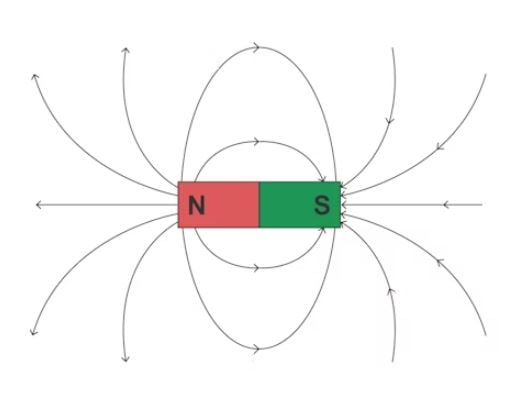The term magnetic field designates a region of space subjected to the action of a force coming from a magnet. It also characterizes the influence of an electric charge in motion and exerts, reciprocally, its action on the charges in motion.
Table of Contents
The magnetic field is one of the components of the electromagnetic field. In the presence of a magnetic field, various phenomena can be observed on materials:
- paramagnetism;
- diamagnetism;
- ferromagnetism.
There are many applications of magnetic field. They range from the attraction of magnets and the orientation of compasses to the storage of information on hard disks, passing through particle accelerators or synchrotron radiation.
Earth’s magnetic field
The Earth, like other planets in the Solar System, is protected by a vast magnetic field which it derives from the movements of its liquid metallic core. This field, subjected to the solar winds, is not uniform. Its value varies between 30 and 60 μT depending on where you are located on the planet.
At certain times in history the earth’s magnetic field has reversed, with the north pole taking the place of the south pole. And this can happen again.
Magnetic field / magnetic field strength (H)
The magnetic field is an electromagnetic energy field that transmits the forces of a magnet.
In drawings, the magnetic field is often represented by field lines. In practice, it is also possible to make it visible, for example by depositing iron filings on a sheet under which there is a magnet.

The lines of the magnetic field always go from the north pole to the south pole of a magnet and from there they pass through the magnet and return to the north pole in such a way as to create a closed circle.
The magnetic field is symbolized by the letter H and measured in Ampere per meter.
We can think our Earth as a big magnet with 2 poles as well.
History of Magnetic Field
From the sixth century BC. AD, Greek philosophers described and attempted to explain the effect of magnetite-rich ores. These rocks came from the city of Magnesia, among others: it gave its name to the phenomenon.
The Magnetic needle compass is mentioned for the first time in the 11th century by Shen Kuo and, even if there are attestations of the knowledge of the magnet in China as early as the 3rd century BC. AD, the problem of terrestrial magnetism appears much later.
The use of the compass in navigation techniques dates from the 12th century and its exact use remains to be clarified due to essentially coastal navigation at that time.
Compasses made use of the earth’s magnetic field, which today happens to be roughly aligned with the earth’s axis of rotation, which is why a compass, by pointing to the magnetic pole, also indicates (albeit approximately) the direction of the earth’s geographical pole.
In the West, Pierre de Maricourt was one of the first to work on magnetism and published his Epistola de magnete at about the same time as the Chinese scholars.
Beyond the simple problem of priorities, it would be interesting to know how certain techniques were able to travel and whether it is not possible that parallel developments, and chronologically almost concomitant, occurred.
For the encyclopedists of the Enlightenment, “magnetism is the general name given to the different properties of the magnet”.
They attribute its effects to a “subtle matter, different from air” (because these phenomena also take place in a vacuum) which they call magnetic.
Further they affirm that “it is still a question not less difficult than to know if there is some relationship between the cause of magnetism & that of electricity, because one does not know much better one than the other.
Until the early 1820s, only the magnetism of natural magnets based on magnetite was known. Hans Christian Ørsted showed in 1821 that an electric current flowing through a wire influences a nearby compass needle.
However, he was unable to explain this phenomenon in the light of the knowledge of the time. The same year, Michael Faraday enunciated Faraday’s law, which traced a first link between electricity and magnetism.
In 1822, the first electric motor was invented: Barlow’s wheel.
André-Marie Ampère soon after proposed a phenomenological law, now demonstrated in the general framework of electromagnetism, called Ampère’s theorem, which links the magnetic field to currents. Shortly thereafter, in 1825, electrician William Sturgeon created the first electromagnet.
In 1873, James Clerk Maxwell unified the magnetic field and the electric field in the theory of electromagnetism.
In so doing, he discovered an incompatibility between the laws of classical mechanics and the laws of electromagnetism.
The latter predict that the speed of light is independent of the speed of an observer with respect to the source which emits the light, a hypothesis incompatible with the laws of classical mechanics.
In 1873, the Belgian engineer Zénobe Gramme discovered the first direct current electric motor, usable on a large scale.
In 1887, the Americans Albert A. Michelson and Edward Morley experimentally verified (Michelson-Morley experiment) the predictions of Maxwell.
In 1905, Albert Einstein resolved the paradox discovered by Maxwell by showing that the laws of classical mechanics must in fact be replaced by other laws, those of restricted relativity.
In 1933, Walther Meissner and Robert Ochsenfeld discovered that a superconducting sample immersed in a magnetic field had a tendency to expel it from its interior (Meissner effect).
In 1944, Lars Onsager proposed the first model (called Ising model) describing the phenomenon of ferromagnetism.
In 1966, Doctor Karl Strnat discovered the first samarium-cobalt magnets, with phenomenal energy.
In 1968, pulsars were discovered, extraordinarily dense stellar corpses, the seat of the most intense magnetic fields existing today in nature.
In 1983, an international team created neodymium-iron-boron magnets, the most powerful permanent magnets known to date.
In 1998, a Russian team created a pulsed magnetic field by an explosion that reached 2,800 T.
On December 12, 1999, an American team created a continuous magnetic field with an intensity of 45T.
In 2006 pulsed magnetic fields reached 100T without destruction.




